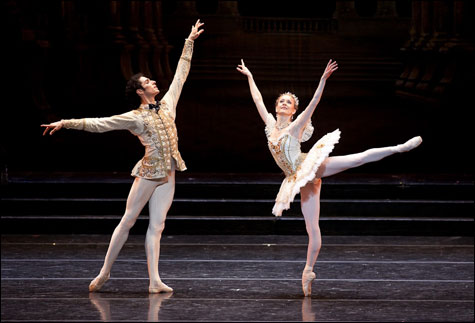
PARTNERING WITH ASSURANCE: Carlos Molina and Larissa Ponomarenko were doing fine until Molina limped off. |
Nineteenth-century ballets are not all alike. But Boston Ballet's Sleeping Beauty is the real McCoy. Opening last Thursday night at the Wang Theatre (where it'll run through May 3), it delivers what the classical ballet tradition means at its most expansive and profound: the opulent staging, the splendid music, the classic romance, and above all the technical challenge that gives dancers a chance to surpass themselves.The current production was envisioned in grand style by the English designer David Walker for the Royal Ballet. Walker died in December, and the Boston performances were dedicated to him. Beginning in a Rococo throne room with high, ornate archways, burnished surfaces, and silken fabrics, the setting moves outside to a formal garden, then to a forest, and then deeper into a primeval terra incognita, where space is suspended and magical forces hold sway. When the spell is finally accomplished, order is restored and a happy ending can be celebrated back in the palace.
Tchaikovsky provided a wonderfully theatrical platform for the story of power and revenge, innocence, beauty, and love. Although The Sleeping Beauty is three hours long, Jonathan McPhee and the orchestra propel us through the drama, progressing from the composer's extended musical build-ups for the Christening of the Prologue and the first appearance of Princess Aurora in act one to the great trademark scenes: the Rose Adagio, the Vision, and the Grand Pas de Deux.
Tchaikovsky moves the social action ahead to span Aurora's 100-year sleep by making dance numbers in 18th-century classical style — a minuet, a gavotte — for the prince's hunting party and a group of peasants at the beginning of act two. He devises sparkling rhythms and colorations for the Fairies' variations as they bestow their gifts on the infant Aurora, and amusing vignettes for the storybook divertissement characters in act three. The whole score is almost symphonic in the way it knits together the many dance numbers, the transitions, the grand processions, and the concluding mazurka.
Thursday night's Aurora was company prima Larissa Ponomarenko. She's a small, delicate dancer whose understated precision contrasted effectively with the extroverted qualities of Erica Cornejo as the Lilac Fairy and the other women soloists, Megan Gray, Heather Myers, Melissa Hough, Misa Kuranaga, Sarah Wroth, and Kathleen Breen Combes. Despite some male ensembles and brief solos, and Aurora's Prince Florimund, Sleeping Beauty is really a women's ballet. Boston Ballet's fine contingent of young classicists is showcased to great advantage here. Especially engaging were Kuranaga as the Songbird Fairy, Gray with Altankhuyag Dugaraa as the Cats, Myers and Wroth partnered by Pavel Gurevich in the Pas de Trois, and Breen Combes with James Whiteside as the Bluebirds.
The wicked fairy Carabosse is often played in drag, but Melanie Atkins on opening night was a glamorous villain, like some brittle Woman Scorned in a 1950s movie. Full of pent-up fury, she unleashed curses and mirthless laughter, using her eyes to great effect without having to wrinkle her make-up.